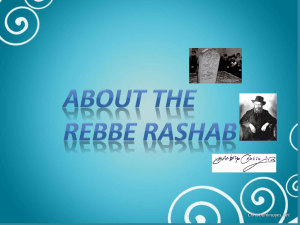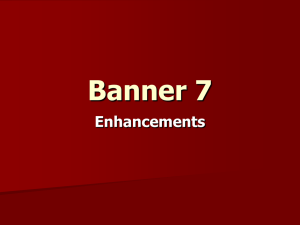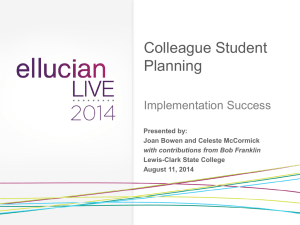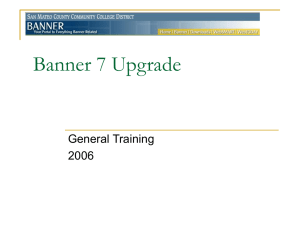Web Tailor Basics
advertisement
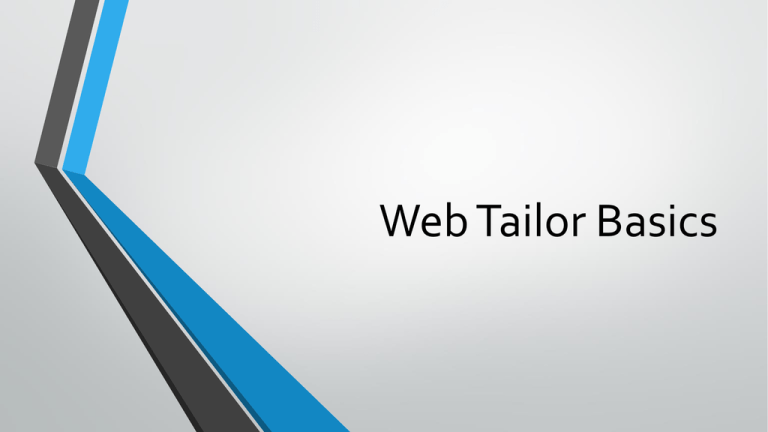
Web Tailor Basics Web Tailor Overview • • • • • Banner Web Tailor lets you build the look, feel, and unique personality of all your institution’s web applications, so you can personalize your institution’s interface to the world. Web Tailor delivers customizable global web rule definitions and procedures, customizable menus, menu items, graphics and text definitions. You must install Web Tailor before installing any other Banner Self-Service application. Web Tailor Functions • • • • • Web menus and procedures • This function allows you to define the menus that will appear on your institution’s web pages for the different Self-Service applications, and specify the procedures behind them. Menu items • This function allows you to define the items that will appear on the menus on your institution’s web pages. Web Tailor Functions • Information Text This function allows you to add or customize Information Text (Info Text). Info Text • can be: • • • • • • • Instructions on how to use a page Help for the page Error messages User roles This function allows you to change the role or roles that a person has been assigned to. For example, you can select the check boxes for Advancement Data Tailor and Development Officer to give someone those roles. Web Tailor Functions • • • • • Web rules This function allows you to define certain rules for your institution’s web pages. For example, you can identify the number of minutes a person can be inactive before they are timed out, or specify the format for the date and time information that appears on your pages. Web Tailor Functions • • • • • • • • Web modules This function allows you to modify a specific Self-Service application, e.g., Accounts Receivable, Student Self-Service, Web Tailor Administration, etc. You can make specific changes to that one application. For example, you can enter a location URL of the Cascading Style Sheet (CSS) that applies to Advancement Self-Service alone. The Advancement Self-Service application would use that CSS and the other applications at your institution could use different ones. Each of your modules could have a different look-and-feel. Web Tailor Functions • • • • • • • • Web Tailor parameters This function allows you to customize parameters used in Web Tailor processing, such as the maximum length of PINs. You must exercise great care when modifying these parameters. Graphic elements This function allows you to specify the images that will be available to be used on your web pages. For each image, you can specify its name, the directory where it is located, and its height and width. Web Tailor Functions • • • • • • • • • Login return location Use this function to specify the page you would like to be displayed when a user is timed out, then logs back in. Web Tailor overrides This page allows you to replace certain procedures and functions with your own under certain circumstances. This is necessary because you may have a stand-alone product you would like to use with the Self-Service products, and you need to use some of the procedures and functions in the other system. If an override is defined, that code will be run instead of the Web Tailor code Technical Basics • • • • • • Technical Configuration Banner Self-Service uses PL/SQL stored program units, which streamlines the call and retrieval process for query and update functionality. The Self-Service programs are written in PL/SQL and are stored as PL/SQL packages, procedures, and functions. The Self-Service applications are designed around a library of stored subprograms. Technical Basics • • • • • • • • • • Interaction with APIs Web Tailor supports the integration of Banner and Banner Self-Service with Application Programming Interfaces (APIs). An API is a program comprised of three different packages: 1. The primary package that contains the create, update, and delete functions 2. A rules package that contains subprograms that support the primary package 3. A strings package that contains error messages and functions Programs within Banner (including forms, C processes, and the Self-Service packages) call common functions and procedures in the APIs as needed. External systems that create, update, or delete information stored in Banner tables can also call the APIs. Technical Basics • • • • • • • • • User interface The look and feel of the Banner Self-Service products are defined by the selection of one of two distinct themes, default and cascade. The use of themes allows the same content to be displayed in different ways Default theme: The default theme has the following design elements. • Use the Verdana font • Includes separate bars consistent with the Banner 7 and 8, Luminis 4 look and feel. • Provide a consistent place to render error messages to assist the user in determining when validation issues occur. Technical Basics • • • • • • • • User Interface: Cascade theme The Cascade theme provides Web 2.0 functionality within Banner Self-Service. This theme adds rich user interaction to Banner Self-Service such as auto complete functionality, button mouse-over state changes and in page refreshes to provide the end user a compelling user experience. Note Javascript must be enabled for the Cascade theme to be used. Technical Basics • • • • • • • • Naming conventions The Banner Self-Service products are made up of packages, C programs, HTML files, and GIF and JPG files, javascript, and Cascading Style Sheets (CSS). Each object’s name is eight characters long, and the position of each letter identifies a particular quality or attribute of the package or program. All Web Tailor package names begin with the four characters TWBK, and do not have a module code in the fifth position. In a Web Tailor package, the characters in positions 5 through 8 are all devoted to the unique package name. Technical Basics • Cascading Style Sheets Web Tailor uses Cascading Style Sheets (CSS) to control the way documents are presented via the browser. • Control the way documents are printed. Web Tailor CSS files are stored in the wtlweb/htm subdirectory of the web server. Technical Basics • • • • • • • • Cascading Style Sheets: Web Tailor includes the following CSS files for the default theme: • web_defaulthome.css This CSS contains the setting for the Self-Service home page. • web_defaultmenu.css This CSS contains the settings for the Self-Service menu pages. • web_defaultapp.css This CSS contains the settings for the Self-Service application pages. Using Web Tailor • • • • • Web Tailor lets you build, customize, and modify the pages in your institution’s Web systems. It is a component of every Banner® Self-Service application. Although Web Tailor is a separate product, its effects appear only when used in conjunction with Banner Self-Service. All of the applications require both Web General and Web Tailor. Using Web Tailor • There are three levels of settings maintained in Web Tailor: • 1. Global - applies to all the Self-Service products • 2. Module - applies to a single module, e.g., Student Self-Service • 3. Procedure - applies to a single procedure, e.g., bwgkomar.P_SelectMtypUpdate • (Update Marital Status) Web Tailor Menu • • You must have Web Tailor Administrator Role. Menu Options Available: • • • • • • • • • • • Web Menus and Procedures Menu Items Information Text User Roles Web Rules Web Modules Global User Interface Settings Web Tailor Parameter Graphic Elements Login Return Location Web Tailor Overrides Web Tailor Technical • • • • • • • Baseline and local records Menus, menu items, roles, and Info Text are separated into two categories: 1. Baseline - you cannot change baseline records in any way. 2. Local - you can create local records and modify them, and they will never be overwritten by later versions of Banner. You can customize menus, menu items, roles, and Info Text as much as you want without losing anything during upgrades. Looks for Local copies first, then Baseline. Web Tailor Technical • • • • • • • • • • Web session processing and security There are two important security considerations to address with respect to allowing end users access to the Banner administrative database through the Web: • You must ensure that any attempt to break into the system with existing Banner IDs (e.g., by guessing PINs) is tracked and Web account access is disabled if appropriate. • You must track Banner database access and ensure that the ID currently logged on is accessing and updating only records associated with that ID. The Web Session Information Table (TWGBWSES) supports session security for both of these concerns. Web Tailor Technical • • • • • • • • Preventing break-ins To address the first situation, a counter for tracking login attempts associated with an existing ID is updated in the Web Session Information table (TWGBWSES). The counter (TWGBWSES_LOGIN_ATTEMPTS) has an initial value of zero. If the ID is valid but the PIN is not, the value of the counter is incremented by one. Additional attempts for the same ID are permitted, up to the value specified for the number of Login Attempts in Web Tailor. When the counter reaches the value specified for Login Attempts, the account is disabled, and the counter is reset to zero. Web Tailor Technical • • • • • Monitoring ID/PIN instances To address the second concern, Banner Self-Service uses hidden and randomlygenerated Web IDs during the entire Banner Self-Service session to track whether the ID and PIN logged on are, in fact, the same ID and PIN for the duration of the session. The TWGBWSES_WEBID field and the TWGBWSES_PREV_WEBID fields track this information. Web Tailor Technical • • • • • • User roles in Self-Service determine what menus are displayed after logging on and what each person has access to. Users can see and access only those menu items that their roles authorize them to see. A user may have more than one role. Roles are not the only factor that determine which pages a user can access. For example, a student will not be allowed to register for classes if the individual’s current general student record is not active. Web Tailor Technical • Standard Banner web roles • • • Automatically assigned based on required records within Banner. GOVROLE view gathers information from Banner to determine the roles. Possible Standard Banner Roles: • • • • • • Alumni Employee Faculty Student Finance Financial Aid Web Tailor Technical • Manually assigned web roles – Roles assigned on the Update Users Roles page in Web Tailor • • • • • Web Tailor Administrator Development Officer EPAF Administrator Master Salary Planner Advancement Data Tailor

